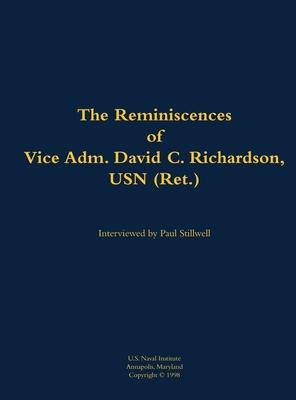After growing up in Mississippi, Richardson attended the Naval Academy, where he was on the boxing team. Following his graduation in 1936, he served as a junior officer in the battleship USS Tennessee (BB-43), and was on board when she went aground in San Francisco in 1937. He completed flight training in 1940 and reported to Fighting Squadron Five; the squadron was at times in USS Saratoga (CV-3), USS Ranger (CV-4), USS Yorktown (CV-5), and USS Wasp (CV-7). He flew F3Fs and F4Fs, including combat in the latter during the Guadalcanal campaign in 1942. Later in the war he was involved in tactical aviation training in Florida and carrier group readiness training in Hawaii. After the war Richardson studied at the Royal Navy Staff College in London, later at the U.S. Naval War College, where he helped write analyses of wartime battles. He commanded Carrier Air Group 13 in the USS Princeton (CV-37), helped plan for the NATO military structure, and then was XO of the escort carrier USS Badoeng Strait (CVE-116) off Korea. After duty in aviation planning for ComAirPac and OP-05, he was on the CinCSouth staff in Naples, then commanded the oiler USS Cimarron (AO-22) and ASW carrier USS Hornet (CVS-12). He had a tour from 1961 to 1964 in the OP-06 organization in OpNav, then served as Commander Fleet Air Norfolk during his first flag tour. In 1966 Admiral David McDonald, the CNO, chose Richardson to command Task Force 77 during carrier air strikes against North Vietnam. In that billet, Richardson did much to integrate intelligence, planning, and operations. After a tour as Assistant DCNO (Air), he served as Commander Sixth Fleet in the Mediterranean, 1968-70. That tour was notable for Richardson’s role in creating the Ocean Surveillance Information System to monitor Soviet naval operations. His final active tour was as Deputy CinCPacFlt prior to his retirement in 1972. Since that time he has remained quite active in various roles in connection with the naval intelligence community.
| FindBook |
有 1 項符合
Reminiscences of Vice Adm. David C. Richardson, USN (Ret.)的圖書 |
 |
Reminiscences of Vice Adm. David C. Richardson, USN (Ret.) 作者:Richardson 出版社:US Naval Institute Press 出版日期:2017-09-18 語言:英文 規格:精裝 / 362頁 / 27.94 x 21.59 x 2.06 cm / 普通級/ 初版 |
| 圖書館借閱 |
| 國家圖書館 | 全國圖書書目資訊網 | 國立公共資訊圖書館 | 電子書服務平台 | MetaCat 跨館整合查詢 |
| 臺北市立圖書館 | 新北市立圖書館 | 基隆市公共圖書館 | 桃園市立圖書館 | 新竹縣公共圖書館 |
| 苗栗縣立圖書館 | 臺中市立圖書館 | 彰化縣公共圖書館 | 南投縣文化局 | 雲林縣公共圖書館 |
| 嘉義縣圖書館 | 臺南市立圖書館 | 高雄市立圖書館 | 屏東縣公共圖書館 | 宜蘭縣公共圖書館 |
| 花蓮縣文化局 | 臺東縣文化處 |
|
|
圖書介紹 - 資料來源:博客來 評分:
圖書名稱:Reminiscences of Vice Adm. David C. Richardson, USN (Ret.)
|






![塔木德:猶太人的致富聖經[修訂版]:1000多年來帶領猶太人快速累積財富的神祕經典 塔木德:猶太人的致富聖經[修訂版]:1000多年來帶領猶太人快速累積財富的神祕經典](https://media.taaze.tw/showLargeImage.html?sc=11100697818)




